Strands of Light

I love the versatility of fiberoptic lighting: The technology works equally well in conjunction with landscaping or architectural features, and because there’s no electrical current to worry about at the light fixtures themselves, they’re a natural around water.
Better yet, you can use fiberoptics to create traditional point-light sources, or you can set them up as mellow bands of light over long stretches. I don’t use fiberoptics on every job, but when the situation is right and the customer is willing, I’m eager to dig in and design a system that will wow them for years to come.
As is true with any lighting system, the main reason to use fiberoptics is safety: They convey information to those walking near a watershape after dark and help prevent accidents. But as we’ll see, there’s more to fiberoptic systems because of their ability to illuminate certain special watershape effects.
On the project seen here, for instance, we used fiberoptics for four distinct purposes: three point lights to provide subsurface water illumination; a pair of bands to mark four steps leading down to the pool deck; a pair of single point lights to add a special glow to a laminar-flow jet on the deck; and point lights to illuminate the spa and the pool’s surge tank.
DEVELOPING A PLAN
Fiberoptics is a flexible, accessible technology, and installation isn’t particularly difficult. Yes, there are certain steps to which you must pay careful attention, but by and large, once you master the fundamentals you’ll find that it’s pretty easy to make the most out of these systems.
On any fiberoptic job, we start with a site plan – that is, an overhead view of the watershape and all adjacent areas. We begin by establishing locations for the light fixtures and then where we think the illuminators should go. (The remotely installed illuminators provide the light source for the fiberoptic cables.)
|
Lighting Tight Spaces At our company, we service all of the pools and spas we build. This means we’re thinking about the service technician as we design and build each project. On the job discussed in the accompanying text, we gave the service technician a hand by installing a fiberoptic fixture inside the surge tank so he or she can see what’s going on when it comes time to do some cleaning. (A typical pool light could not be used because of the constantly changing water level within the tank.) This light is controlled by the same illuminator as the spa’s light fixture. — P.B. |
It’s important to note that keeping cable runs to a minimum length is of key importance, because the intensity of light in the fiberoptic strands diminishes with distance, even in straight-line applications. This usually means that, for any given project, illuminator boxes will be installed at different locations around the perimeter.
In this case, for example, the illuminator for the pool lights was installed outdoors, up against the house, while the illuminator for the steps was installed in a utility closet inside the house. In addition, the illuminator for the spa and surge tank lights was installed at the equipment pad, while the illuminator for the laminar jets was installed in a flowerbed near the fence.
In what follows, I’ll focus primarily on the steps and the in-pool lights: These are representative of most of the fiberoptics installed with watershapes. You’ll also find brief discussions of, respectively, spa/surge tank and laminar jet lights in the two sidebars appearing to the left and just below.
|
Streams of Light As mentioned in the companion story, we installed two laminar jets in the deck near the pool. The nozzles for this system were manufactured by Crystal Fountains of Concord, Ontario, Canada, and are made to include fiberoptic lights. The effect is truly mesmerizing: The tight, arcing streams of water are lit from within and glow uniformly for a remarkable distance – a subtle and eye-catching effect. The illuminator for the lights in these jets is located in a nearby flowerbed. — P.B. |
In developing an approach to any fiberoptic system, I rely heavily on technical support from manufacturers. In this case, for example, I sent a copy of the site plan with all the relevant dimensions and had indicated where I was going to put all of the light fixtures and illuminators.
Why the need for help? Simple: The technical support staff takes my plan, calculates the distance of runs away from the illuminators and decides how many strands are needed per cable to yield a balanced, even light pattern. They also calculate light absorption due to surface materials and dark colors – things I’d rather not tackle myself.
On this job, for example, we had one 65-foot run from the illuminator to the pool lights that required a 125-fiber cable for each fixture. This gave us a total of 375 strands going back to the illuminator, which was fine, because the models we were using could handle up to 500 strands.
We used the Super Vision lighting system from Hayward Pool Products of Elizabeth, N.J., for this particular project. I’ve used all the major brands, however, and find that not only do they all work well, but also that technical support is good across the boards.
THE BUSINESS END
The bands of light we installed on the granite steps near the pool came about to address a basic safety issue: Everyone on site quickly recognized that you couldn’t clearly see the step or get of a sense of their depth at night.
In this case, we located the illuminator in the house and so had to core-drill through the foundation to pull the cable back to the illuminator over the shortest possible route. The cable used for band-light applications is different from the kind used for point-lighting effects in that it is designed to allow the light to escape along its length. Here, the outer casing is clear, exposing fibers that are woven in a braid or rope-like pattern around a reflective center core.
In this case, we used four cables of 42 strands each – one for each step – and ran them back to the illuminator. Using clamps, we glued the special track for the light in a space we’d left in the granite tiles we used as facing (Figures 1 and 2). One step alone required more than 100 feet of fiber due to its arced shape – even though the step is only 40 feet across if measured in a straight line.
| Figure 1 and Figure 2 |
Each cable was installed in a loop, with both ends polished and terminating at the illuminator. We did so because band lighting loses light along its run; running a loop ensures even light along the entire length of the fiber.
Here we come to one of those small yet significant details of the installation process that boils down to on-site supervision: In a hardscape like this one, you have to make sure your mason understands what you need and leaves enough space for the cable. (Note: The material seen here is flamed and honed Italian granite.)
As was just mentioned, cables of a different sort are used for fiberoptic point lighting: In this case, you leave the sheathing intact with the intent of delivering as much luminosity as possible at the fixture. To that purpose, both ends of the cable must be polished (which I’ll discuss later), and the cable must be worked with and pulled carefully through conduits to avoid damage to the fiber bundles or individual fibers within those bundles.
For the in-pool lights, we punctured the shell with the conduit before the gunite was shot (Figures 3 and 4). The pipe was cut off flush after the gunite cured, at which point we pulled the cable through. This is definitely easier said than done, because the outer shell of the cable has a certain stickiness to it and is difficult to pull even through a lazy, sweeping turn. We used wire lube, however, which made things much, much easier.
| Figure 3 and Figure 4 |
The first key to success in laying out cable runs is, as we’ve mentioned, minimizing length. The second is to limit the number of turns. Where turns are necessary, they must be sweeping, which is why we work with flexible schedule 40 PVC tubing.
BACK AT THE BOX
The illuminator is the device that actually generates the light that is in turn transmitted by the fibers, either as a point fixture or along a cable band.
Each illuminator contains a lamp, a reflector, a color wheel and some associated electronics and wiring. The illuminators chosen for this job are fairly delicate devices with glass parabolic reflectors; they must be handled carefully to avoid damaging critical components. (Some reflectors are made of aluminum and are less fragile, but they don’t put out as much light. I needed maximum output for this job.) The lights themselves are metal-halide halogen bulbs rated for 6,500 hours of operation.
These illuminators come with a burial box that is set below grade. All conduit runs are brought into the box and up into the illuminator housing. Once the conduits and box are in place, soil is packed around the box (Figures 5 and 6). The lamps and color-wheel motors generate a fair amount of heat, which means that all these boxes should be placed in areas with a good, cooling airflow.
| Figure 5 and Figure 6 |
Installing the illuminator involves three types of wiring connections: the fiber cable, a power feed and a low-voltage control (Figure 7). The low-voltage control cable consists of 4-conductor, 18-gauge shielded wire that’s run in its own conduit system – which in this case was linked with the conduit housing a computer control system supplied by Laars and Jandy Pool Products (Petaluma, Calif.) for the pool and the spa. Here, the illuminators run on 120-volt power hardwired to the home’s sub-panel and relays and via the pool/spa controller.
| Figure 7 |
Some illuminators on the market have separate power circuits operating the color wheel and the light. On the systems I used here, the light and color wheel share power circuits, but they can be turned on an off independently via an internal relay – an option I chose in this case. This allowed us to synchronize all the color wheels through a single controller.
This synchronization isn’t standard, but it was what the customer wanted. So we worked with Super Vision and the technical staff at Jandy to develop the wiring scheme required to make all the lights and wheels operate together.
The way it works is all the wheels spin whether or not the bulbs are on. That way, even if one of the lighting systems is not being used, the wheel remains in synch with the rest of the system – and when the lights do come on, all of the colors change in unison.
POLISHING THE ENDS
Beyond getting the cable to cooperate in being jammed through conduits, the one tricky step in all of this installation process is cutting and polishing both ends of all fiber cables. As mentioned above, for the band lighting it ensures even light distribution along the full length of the cable. For point source lighting, polishing maximizes light flowing into the cable at the illuminator and increases the light received at the lens. All of this works to maximize output lumens.
To start, we cut the cable to a rough length – plus three inches. Then we slice into the outer sheath with an X-Acto knife, peeling the skin back like a banana and cutting it away. It’s very important not to slice or scrape the outer length of the fiber, so be careful!
At the illuminator end, we snap on a plastic ferrule to crimp and tightly bundle the fibers together. This ferrule fits into a bracket or reducing bushing in the light fixture itself (Figure 8). As needed, you may end up adding short, dummy fibers to tighten the bundle and pack the bushing as tightly as possible.
| Figure 8 |
Cutting the cable is a two-person job: One holds the cable while the other slices the fibers with a hot knife.
This cut is extremely important: You must use even, downward pressure with the hot knife and avoid sawing back and forth. (A saw cut will create a gummy mess.) Be patient: It takes about 10 or 15 seconds to cut each bundle if you’re doing it right. And if you’ve never cut fiberoptic cable before (other than accidentally), I suggest getting some scrap and practicing before you do it on the job. It’s not hard, but it does require a touch.
Next we use a polishing kit to polish the ends of a fiber. (According to one leading manufacturer, this process adds 10% to 15% to light output.) The polishing itself is simple: You work methodically through a series of wet and dry polishing steps, moving from coarse to fine and extra-fine grits.
We polish the fibers to increase light output and also to make certain no stray fibers extend past the reducer bushing to interfere with the motion of the color wheel. Then, for point-light fixtures, we move to the other end of the cable, repeating the process in setting up the cable at the fixture’s centering disk (Figure 9).
| Figure 9 |
At the fixture locations, we countersink the gunite around the fixture so that the pool finish can be packed in to prevent leakage. (It’s important to keep water out of the conduit to avoid condensation on the fixture’s lens.) The lens itself fits over the cable and is sealed by two O-rings that should be lubricated before the lens is installed (Figures 10 and 11).
| Figure 10 and Figure 11 |
That’s it: Time to fill the pool and spa with water, turn on the lights and enjoy the glowing results.
Paolo Benedetti is principal at Aquatic Technology Pool & Spa, a design/build firm based in Morgan Hill, Calif. He may be reached at paolob@aquatictechnology.com.





















